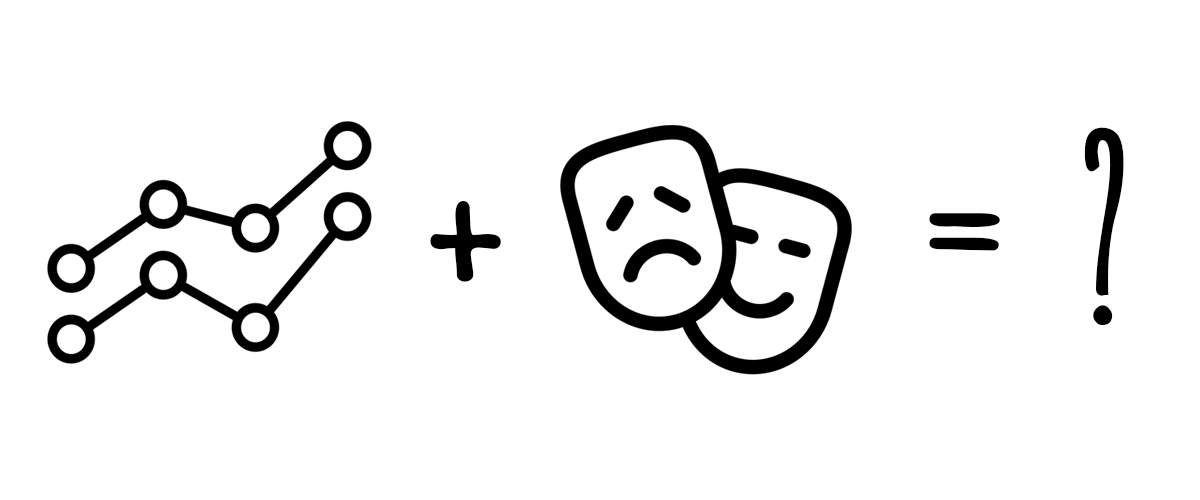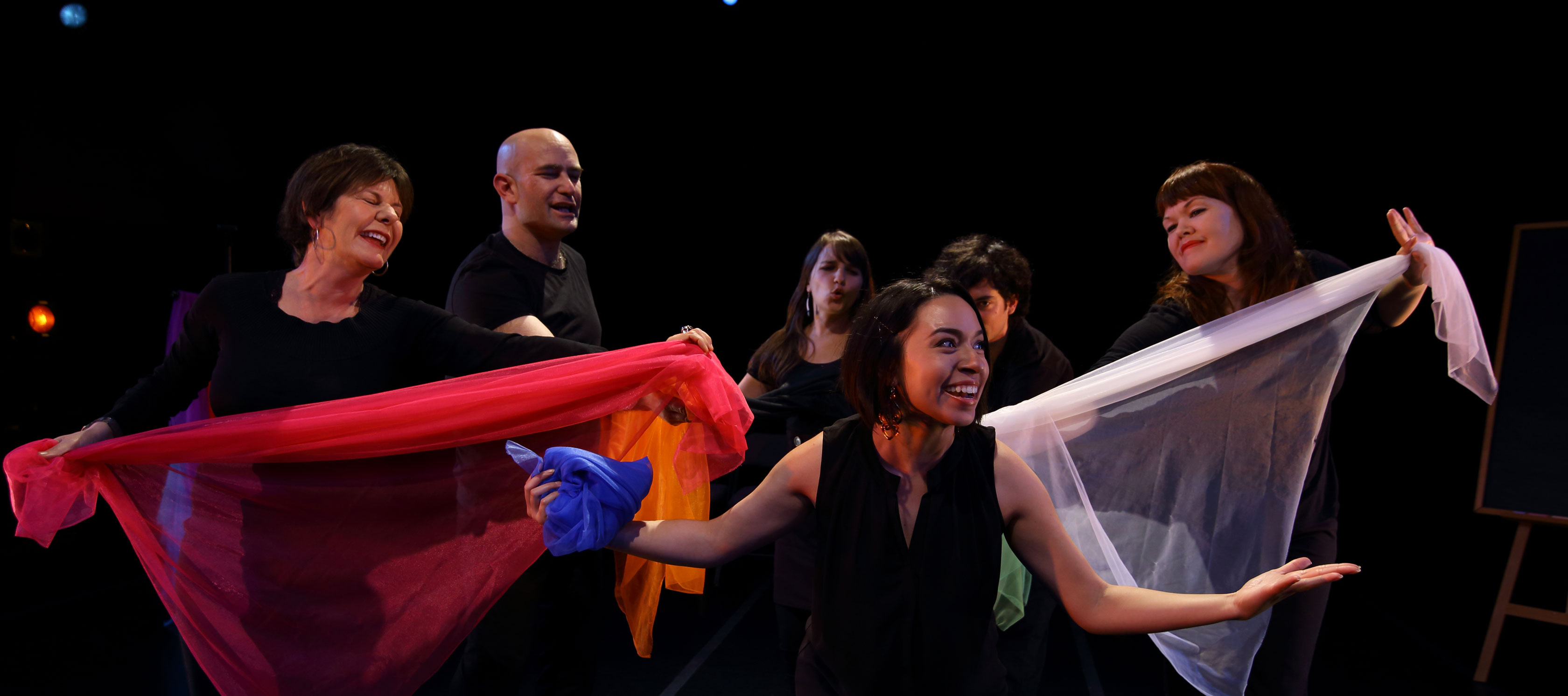Last year, we came together and started exploring the experience of data through movement with our first “Data Moves” workshop. Our driving questions related to how these interactive and somatic methodologies could enhance the way we engage with information. We started with a simple question - what happens if we dance our data? Among many observations from that workshop, we saw a distinction between those who didn’t feel comfortable moving in a dance-like way and those who did. As a result, some participants began to create skits from the data stories they found. This sparked the idea of exploring the world of theatre alongside dance, in order to uncover the rich resources and pathways theatre has to offer. How can we create theatre-based experiences that bring people together around data in social contexts, in order to build empowerment, challenge power structures, and build capacity to speak the new language of data? In particular, what does this mean in our current pandemic, where the arts are reworking and reimagining themselves in response to social distancing guidelines?

This blog post summarizes a review of interdisciplinary literature on data performance through theatre, as well as case studies of potential theatrical approaches in social justice contexts. We derive a list of key observations that will inform the next phase of our investigation in data skits. These key takeaways serve as a preliminary starting place for the theatrical avenues that may be worthwhile in a future iterative workshop series.
Blurring The Line Between Audience and Stage
The first key takeaway that we noticed in our literature review is the participatory experience of blurring the lines between actors and spectators, or the stage and the audience. Traditionally, dismantling these boundaries has functioned to eliminate the cathartic element of theatrical convention, and promote audience participation both within and outside the theatre. The audience may have strong visceral and emotional reactions to a piece, but they are more likely to take action when they are invited to act in the experience of the theatre. We found a few different related forms of theatre, each of which offer worthwhile next steps in breaking down the hierarchies in ways that encourage equal participation between actors and viewers.
 Image from Living Arts Playback Theatre (source)
Image from Living Arts Playback Theatre (source)
Playback theatre, used to help people reconcile with their experiences through repetition and storybuilding, uses tools such as “moving sculptures” and “group choir” to reflect and dramatize stories shared by participants. This form of theatre dismantles traditional boundaries in that it forces audiences members to physically build the depth and breadth of their experience, and participate in telling the experience through a given set of performance norms. Participants share experiences that are “played back” to them through different short scene/skit formats, some of which require interaction and reflection. In one research study done with medical students, students were encouraged to share formative moments of their medical education, in order to increase their empathetic reasoning and compassion in the medical education realm. Other projects highlighted healing and reconciliation for post-war communities, mental-health recovery, or healing for adolescents in Palestine refugee camps. Playback theatre aims to create a deeper, multi-dimensional understanding of experiences, which helps in empowerment, decision-making, processing, and reconciliation.
Theatre of the Oppressed, a form of theatre designed for social and political activism, uses participatory theatre techniques to explore oppression in all forms- internal and external, individual and societal, and more. These techniques include “image theatre” activities such as human sculptures, but also problem solving through role play and even staging participatory scenarios involving an unaware public. Traditionally, Brechtian/”epic theatre” also aims to encourage participation and dismantle boundaries, through interrupting the theatrical experience and charging participants with decision making, analysis, and sharing judgement. Verbatim theater, theater crafted using and manipulating the direct words and phrases of participants or source material, has also shown its worth in empowering communities towards political action.
 Image from Theatre of the Oppressed NYC (source)
Image from Theatre of the Oppressed NYC (source)
Although these theatrical methodologies are a drop in the well of participatory dramatic resources, from them we learn the value of dismantling traditional audience/actor boundaries that can be leveraged in data analysis. These forms of theatre, participatory by nature, align with our goal to create participatory spaces that bring people together around data. We have solid approaches to doing this in non-theatrical ways, but the commonground is worthwhile to explore.
Narratives Emerge from Interaction
Another key takeaway from the literature is the value of structuring performance in real time, relying on mutual exploration, rather than beginning with an implicit agenda of disseminating information. This element of shared discovery and storytelling, structurally influenced by the perspectives and experiences of participants, implicates a sense of control and responsibility amongst the collaborators. Rather than starting with a dataset to impart on an audience, beginning with a set of questions can potentially stimulate a richer performative dialogue. These questions can be crafted by a set of data, and then shaped by the participants as they navigate through their interpretive/reactive experience. In the words of social science dramatists and researchers Ross Gray and Christina Sindig, “A drama that emerges from such a process is very much a negotiated settlement, a collective achievement.” This takeaway resonated with our goal of building empowerment through participatory performance - enabling decision making, multi-sensory processing, and an elevated sentiment of self-efficacy.
Our hope is that performative explorations of data will also bolster effective communicative skills. Through performance-based approaches, participants will learn how to speak and embody data, and leverage this knowledge towards goals within their communities.
Shared Goals
The literature also highlighted the structural element of data visualization and performance, in both the process and the outcome. The process and product of data performance occur simultaneously, as a voluntary creative experience allows participants to simulate questions, decisions, and outcomes. Information designer and author Fredrica Fragapane notes that there are 3 commonalities that highlight the mutualistic relationship between theatre and data visualization- they convey information, they visualize, and they represent the result of careful choices. The process of visualizing data for the goal of empowerment requires careful analysis of choices, and a participatory decision making process. This is inherent in participatory forms of theatre, and evidence of the simultaneous aspect of the process and product. This insight connects to our goal, as we want to explore existing datasets to find the stories in them while simultaneously turning these stories into empowerment that leads to action. We aim to increase the participants’ efficacy- their belief that they can influence the system presented in the data to make it better for relevant people and communities. This is reminiscent of the Brechtian theatrical goal of disrupting the status quo, through challenging traditional theatre boundaries and the power structures inherent in the data.
 Image by Frederica Fragapane (source)
Image by Frederica Fragapane (source)
Another inspiration for this work can be found in theatre’s form - a real-time, enacted, performative telling of a story. Data itself does not exist on a two dimensional plane- it results from experiences, observations, and questions. However data is often presented in the abstract, disconnected from the real world phenomenon and people it portrays. Theatre offers us opportunities to reconnect data with its three-dimensionally, in its replication and representation of the human experience. This is very much in line with some of D’Ignazio and Klein’s arguments about Data Feminism - they specifically provoke us to “bring back the bodies”.
The approach of participatory theatre is valuable in reclaiming, reinterpreting, and grappling with data in new ways, which can act as a tool to fight power imbalances within marginalized groups. Theatre isn’t defined by any one of its components- movement, body language, space between bodies, etc. Rather it is a summation/amalgamation that transcends one singular sensory experience. From words, lines, and sentences, to shape, breath, and time, theatre makes use of the intersection of all of these tools. This connects to our pedagogy of constructionism- it harkens back to the approach of body-syntonicity in our early explorations. The invitation to engage in a multi-sensory experience strengthens the outcome of these methodologies. It can be a useful structure to recharacterize and redefine data, to create a more just power dynamic around information.
Next Steps
We are delighted about all of the parallels to our existing work, and new frameworks we can learn from. Our next step is to design activities that bring people together around data inspired by these lessons from participatory theatre. These will revolve around the pre-existing goals that drive our data work - encouraging empowerment, bolstering decision-making, grappling with past experiences, making sens of information, helping those without power learn to “speak” data, and creating a fun space. We’ll be doing this with the added challenge of experimenting in the virtual space, but look forward to learning with community members. Drop us a line if you know of related work, or want to collaborate!


